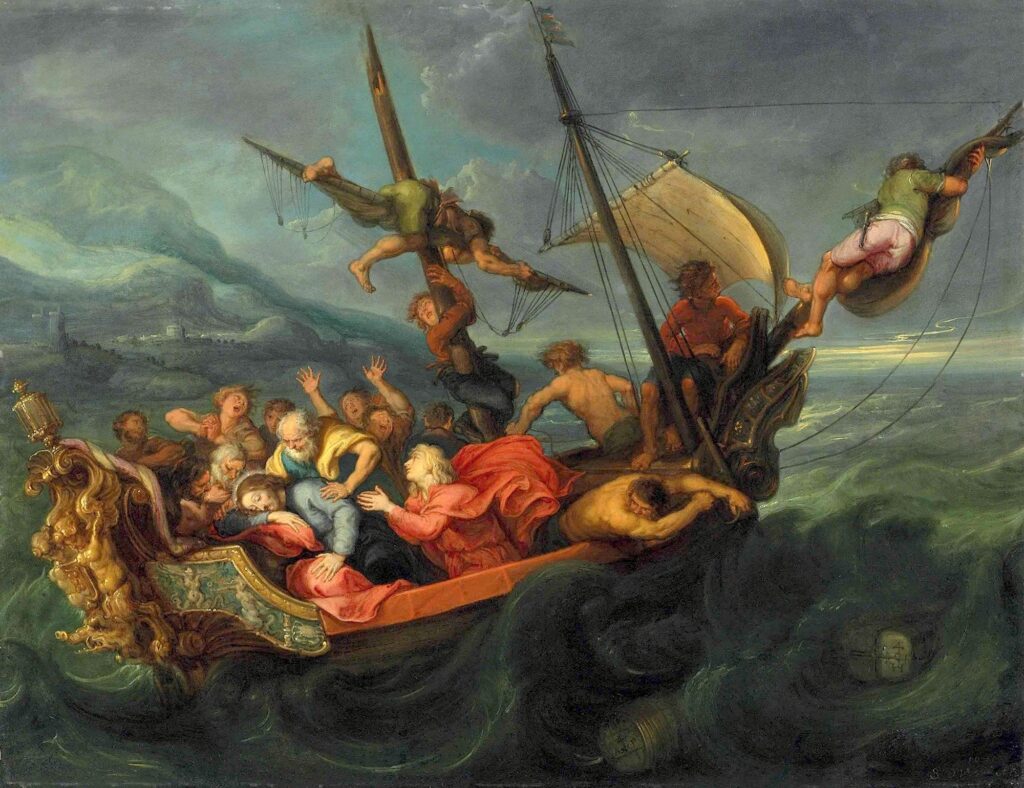Simon de VOS
Antwerp, 1603 - 1676
Christ on the Sea of Galilee
1641
Oil on panel, 72 x 55,5 cm
1641 / S D Vos in et F
Simon de Vos was a famous Flemish painter. In 1615 he became a pupil of Cornelis de Vos (no relation), with whom Jan Cossiers may have been a fellow-apprentice. By 1620 de Vos was a master in the Antwerp Guild of St Luke. For the next eight years he may either have worked in Rubens’s studio or have travelled abroad (Martin). The latter is more likely in view of the similarities between de Vos’s oeuvre and that of Johann Liss, who was in Rome and Venice at that time. This hypothesis is supported by the italianizing characteristics evident in de Vos’s early work. Vlieghe (1988) attributed the Portrait of Three Men (1626; Paris, Louvre) to de Vos and identified the sitters as Jan Cossiers, Simon de Vos and ?Johan Geerlof; if this is correct, de Vos would have painted it in Aix-en-Provence. (De Vos and Cossiers may already have met in Rome between 1624 and 1626.) According to Vlieghe, the iconography of the picture is consonant with the genre works of the Bentveughels (members of the Schildersbent, a confraternity of northern artists working in Rome). De Vos married a sister of the painter Adriaen van Utrecht in 1626 and between 1629 and 1642 took two pupils in his studio in Antwerp, where he worked for most of his life. Among the artists with whom he collaborated were Alexander Adriaenssen and Frans Snyders. De Vos began his career in a rather traditional manner, executing cabinet pictures of genre scenes, including various merry companies and group portraits. Most of these have dense, unbalanced, Mannerist compositions, often constructed pyramidally. Elegant, often exotic, doll-like figures strike Mannerist poses; they have plump faces, rather prominent eyes, heavy eyebrows, full lips and untidy hair. The settings are lightly sketched in and de Vos’s colours are rich and often gaudy. His style is related to that of Frans Francken (ii) and Liss, whose influence is evident in the Caravaggesque treatment of the merry company scenes. Outdoor scenes generally show wide landscapes with a high horizon, with unconnected groups of figures giving the works a feeling of incoherence. Paintings of this period include the Marriage at Cana (1624; Antwerp, Rockoxhuis), the Seven Acts of Mercy (1635; Warsaw, N. Mus.), The Fortune-teller (1639; Antwerp, Kon. Mus. S. Kst.) and the pendants David and Abigail and Solomon and the Queen of Sheba (both 1641; St Petersburg, Hermitage). After c. 1640 de Vos painted mainly religious and history pieces, favouring works with a more spiritual and Christian character. The compositions of these larger works adopt the same structural formulae as the smallscale scenes and thus also lack balance and authority. The figures are large and clumsy, although the putti and playing children add an air of life to what are otherwise works in a forced, fanciful and very sentimental style. In these later years, the influence of Rubens, Claude Vignon and van Dyck became sharper. Paintings of this period include a 12-part series from Genesis (1635–44; Seville Cathedral and elsewhere), the Adoration of the Magi (1643; Salzburg, Residenzgal.) and the Martyrdom of St Peter (1648; Antwerp, Kon. Mus. S. Kst.). The Genesis paintings contain a large number of animals, suggesting that Simon de Vos, like his namesake Paul de Vos, was perhaps also a specialist in that field. Simon de Vos is known to have supplied paintings to the Forchout family firm of dealers and also to have worked for the dealer Chrysostoom van Immerseel. His standing among his contemporaries is indicated by the fact that Rubens owned a painting by him; de Vos’s portrait (1635; Antwerp, Kon. Mus. S. Kst.) was painted by Abraham de Vries (c. 1590–1650 or 1662), and a print of it was included in Anthony van Dyck’s Iconography (Antwerp, c. 1632–44).
Provenance:
Private collection, London
Important private collection, Zurich
Bibliography:
Thieme–Becker; Wurzbach P. D’Arschot: ‘Tableaux peu connus conservés au Brabant, I’, Rev. Belge Archéol. & Hist. A./Belge Tijdschr. Oudhdknde & Kstgesch., xiii/4 (1942), pp. 269–70 F. -C. Legrand: Les Peintres flamands de genre au XVIIème siècle (Brussels, 1963), pp. 57–62 M. Díaz Padrón: ‘Simon de Vos en la catedral de Sevilla’, Archv Esp. A., xxlvii/192 (1975), pp. 397–402 J. Michalkowa: ‘Les Tableaux de Simon de Vos dans les collections polonaises’, Bull. Mus. N. Varsovie/Biul. Muz. N. Warszaw., xvii (1977), pp. 1–21 Le Siècle de Rubens dans les collections publiques françaises (exh. cat. by J. Foucart, Paris, Grand Pal., 1977– 8), pp. 255–6, no. 213 Het aards paradijs [The earthly paradise] (exh. cat. by A. Balis, Antwerp, Zoo, 1982), pp. 100, 102 G. Martin: ‘Two Newly Attributed Works by Simon de Vos’, Rubens en zijn tijd: Bijdragen aangeboden aan R.-A. d’Hulst (Antwerp, 1985), pp. 201–5 R. Klessmann: ‘Eine Bussende Magdalena von Simon de Vos in Braunschweig’, Niederdt. Beitr. Kstgesch., xxv (1986), pp. 69–78 H. Vlieghe: ‘Fecit Simon Cossiers Gerelof: Een zeventiende-eeuws kunstenaarshommage’, Cultuurgeschiedenis in de Nederlanden van de Renaissance naar de romantiek (Leuven and Amersfoort, 1986), pp. 371–7 H. Vlieghe: ‘A propos d’un Portrait de trois hommes par Simon de Vos (1603–1676) au Louvre’, Rev. Louvre, xxxviii/1 (1988), pp. 37–38


